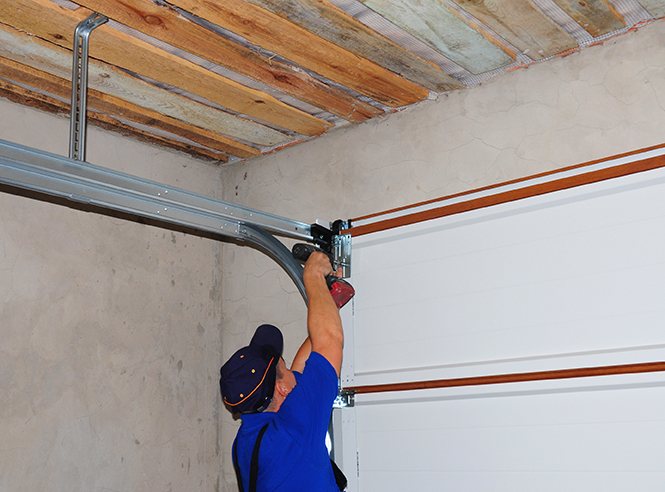Typical Garage Door Issues and Exactly How to Deal with Them
Garage doors are essential for both safety and security and ease, yet they typically present a variety of typical problems that can frustrate property owners. While some concerns may show up simple to resolve, others might require an extra nuanced understanding of garage door auto mechanics.
Noisy Garage Door Operation
A loud garage door procedure can be a significant source of nuisance for house owners, usually suggesting underlying mechanical concerns. Such disturbances may come from various causes, consisting of damaged rollers, loose hardware, or inadequate lubrication. Determining the source of the noise is essential for efficient resolution.
One typical cause of extreme noise is the existence of rustic or damaged rollers. In time, these elements can weaken, causing grinding or squealing sounds as the door actions. Normal examination and replacement of these rollers can substantially minimize sound levels. Additionally, loosened bolts or screws in the door system can create rattling sounds during procedure. Tightening up these fasteners makes sure a more stable and quieter motion.
An additional contributing aspect is insufficient lubrication of the door's relocating components. Using a top quality lube to the tracks, springtimes, and rollers can substantially reduce friction and sound. House owners must perform this maintenance periodically to keep optimum efficiency.
Finally, the garage door opener might likewise create noise as a result of its age or mechanical issues. If the sound continues in spite of dealing with various other variables, getting in touch with an expert for a detailed evaluation and potential repair work may be required.
Door Will Not Open or Close
Experiencing a garage door that will not open up or shut can be unbelievably aggravating and commonly indicates a breakdown within the system. A number of aspects can add to this concern, and identifying the origin is necessary for efficient resolution.

Next, evaluate the security sensors situated at the base of the door. These sensing units can become misaligned or blocked by particles, stopping the door from running appropriately. Tidy the sensors with a soft cloth and ensure they are straightened.
Furthermore, the garage door's internal components ought to be evaluated. Problems such as a damaged spring, damaged rollers, or a damaged opener can hamper activity. If any parts seem harmed, it may be recommended to seek advice from a professional for fixings.
Misaligned Tracks
(Skilled Technicians)Misaligned tracks can significantly disrupt the smooth operation of a garage door, resulting in operational failings such as unequal activity or total immobilization. This concern normally arises as a result of a variety of factors, including deterioration, unintentional effects, or improper setup. When the tracks are misaligned, the rollers can stagnate openly, which not only stresses the motor but also Always Available poses security risks.
To recognize misalignment, aesthetically evaluate the tracks for spaces or uneven spacing. If you notice any inconsistencies, it is crucial to deal with the concern without delay - garage door service. Begin by loosening up the screws that safeguard the track to the wall, enabling adjustments. Carefully touch the track back into its appropriate position utilizing a rubber mallet or a similar device, guaranteeing it is straight and degree.
Regular maintenance, consisting of cleaning the tracks and guaranteeing rollers are in good problem, can stop future misalignments. By dealing with misaligned tracks without delay, you can bring back the functionality of your garage door and improve its durability.
Broken Springs
Among the different parts of a garage door system, busted springtimes are just one of one of the most usual issues that can significantly impede its functionality. Garage door springtimes are important for balancing the weight of the door, enabling smooth opening and closing. When a spring breaks, it can bring about a door that is hard to operate or, in some instances, totally unusable.
There are 2 major kinds of springtimes: torsion springtimes, which are installed over the door, and extension springtimes, found on either side. Indications of a broken springtime include a door that will not open up, a noticeable gap in the spring, or a loud noise during operation. Attempting to run a garage door with a broken spring can cause additional damage to the door or the opener.
Repairing damaged springs is not a DIY project; it calls for specialized tools and proficiency as a result of the high stress included. It is recommended to seek advice from an expert specialist who can securely replace the springtimes and ensure the door is appropriately stabilized. Normal maintenance and evaluations can help prevent spring failings and prolong the life expectancy of the garage door system.
Remote Issues

If the remote still stops working to operate, check the garage door opener to ensure that its sensing units are tidy and unhampered. Dust, debris, or misalignment may prevent the signal transmission between the remote and the opener.
Disturbance from various other electronic tools can likewise restrain remote performance. Ensure that nearby gadgets, such as cordless routers or cordless phones, are not creating interruptions. garage door service. If disturbance is believed, try moving these devices even more far from the garage door opener
Sometimes, the remote might require to be reprogrammed. Seek advice from the supplier's guidelines to reset the remote and synchronize it with the garage door opener. If all else fails and the remote continues to malfunction, think about seeking advice from an expert service technician for an extensive assessment and possible replacement of the remote or opener.
Conclusion
(Effortless Process)In summary, usual garage door issues can considerably affect functionality and security. Positive maintenance and timely repair services can guarantee ideal efficiency and long life of garage doors.